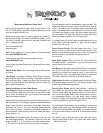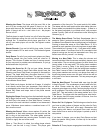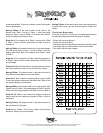
2
3
Winning the Game: The player with the most ‘Ws’ at the
end of all six rounds wins the game! If there is a tie, the
player with the most “Bs” between those in the tie, wins the
game. If there is still a tie – don’t duke it out – the players
have a ‘roll-off’.
The rst player to reach 5 points in a roll-off wins the game.
Players alternate rolling one die until the total reaches or
exceeds ve. To determine which player goes rst in the
roll-off, have each player roll one die, the highest number
goes rst.
Shorter Rounds: If you can’t sit still for long, make 11 points
the goal instead of 21 for each round. This makes the game
shorter.
Party Bunco: For all of you party-hearty players out there,
cramming people into your house, here are rules for 12
players. This involves 3 tables and lots of moving around,
so you may want to provide some refreshments, or just go
ahead and make it a pot luck!
Setting the Scene for 12: Get out your tables, because
you will need three of them! Each table should have the
following: one Round Tally Sheet, one pencil, 4 dice and four
players. The ‘head’ table has a few other items on it – like
the bell and the Master Score Sheet. The main scorekeeper
is seated at this table and writes down all 12 players’ names
on the Master Score Sheet.
Each Table has 4 players, divided into 2 teams. It is helpful
to sit directly across from your teammate. Each table has
a scorekeeper who enters the initials of each player on the
Round Tally Sheet and keeps track of the points earned
each round.
Playing the Game: One player from the head table rings the
bell to begin the rst round. The scorekeepers at each table
roll rst! Play is the same as “One Table Bunco”, however,
the score from each individual is added to her teammate’s
score. Whichever team reaches a combined score of 21
rst, wins the round!
Winning the Round: When a team reaches 21 points, the
scorekeeper at their table announces the winners and the
bell is rung at the head table. The other tables continue
playing until each table has a winning team. The bell is rung
3 times to signify the end of the round.
When a ‘True Bunco’ is rolled, the rolling player shouts
“Bunco!’, and the bell is rung 3 times. The player gets
possession of the fuzzy die. The round ends for ALL tables.
The teams with the most points at the other tables (the non-
Bunco tables) are declared the table winners. If there is a
tie, the teams participate in a civilized roll-off, until one team
scores 5 points. (See roll off instructions under Winning the
Game on pg. 4)
The Master Score Sheet: The Main Scorekeeper (who is
seated at Table 1) enters the results for all of the players on
the Master Score Sheet for the round that was just completed.
Scoring is almost the same as ‘One Table Bunco.’ A ‘W’ is
entered for each member of the winning team at each table.
There should be 6 ‘winners’ in all – 2 per team with 3 tables.
If someone rolled a ‘True Bunco’ then a ‘B’ is recorded in that
player’s scoring row, but not her teammate’s row. Sorry you
have to earn this for yourself – no sharing.
Moving to a New Table: This is where the winners and
losers are divided. After the scores are tallied, players move
to new tables. The non-winning players (in other words, the
losers) rotate to the next table. The losing team members
from Table 1 move to Table 2, the losing team members
from Table 2 move to Table 3 and the losing team members
from Table 3 move to Table 1, the head table. Now while the
losing team members are moving, one player from each of
the winning teams moves over one seat, so that she will be
sitting next to her former teammate. This way everyone gets
a new team.
Start the Next Round: The head table now rings the bell
to begin Round 2. The scorekeeper at each table rolls rst,
as usual. Please rotate the role of scorekeeper so that
everyone gets chance to go rst! Continue playing until a full
set is completed. The winner of the set is the player with the
most “Ws”. Ties are broken in the same manner as in ‘One
Table Bunco.’ The player with the most Buncos wins the tie.
If the players have the same number of Buncos, then the
players participate in a roll-off.
Bunco for 5 to 11 players: The following are rules for when
you have an odd number of players and the rules for Party
Bunco and One Table don’t quite apply. Remember that
when playing with teams, one person from each winning
team moves over a seat so that player is paired up with a
new partner.
If you have 11 players, you can play Party Bunco and just
have one person rolling twice, to make up for her absent
Bunco Partner.
Rules for 5: Three players congregate at one table, and two





